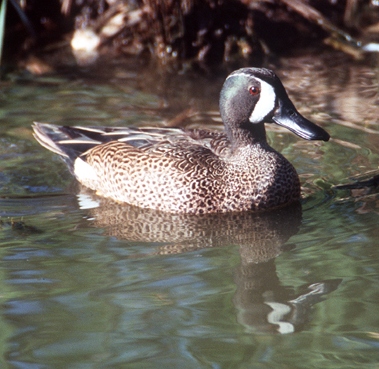|
Blue-winged Teal Anas discors Pato Zarcel,
|
 |
|
Male - Photo: G. Beaton |
|
IDENTIFICATION: A small duck with a brown body and a blue wing patch, especially evident in flight. In breeding plumage the male has a steel-gray head with a white crescent in front. Length: 35-41 cm.; weight: 266-410 g. VOICE: A high-pitched, double whistle; also a quacking note. Audio 2 (M. Oberle). HABITAT: Spends the winter on fresh and salt water ponds, lagoons and mangrove swamps. HABITS: Travels in small flocks and feeds on vegetation near the water’s surface, or by dipping its head into the water. This feeding behavior is called "dabbling," as opposed to diving---the other major type of duck feeding behavior. Dabbling ducks have smaller feet, often placed farther forward on the body, than do diving ducks. The Teal’s diet is mostly vegetable: leaves, roots and seeds of algae, grasses and other water plants. It also eats some molluscs, insects, and crustaceans. Pairs start to form before the Teal migrates from Puerto Rico in March and April. It breeds in northern North America where the female builds a simple nest: a scrape in the earth, hidden by dense vegetation near water. She lays 8-11 eggs and incubates them for 21-27 days. The young fledge 35-44 days after hatching. Sometimes other duck species lay their eggs in the nest of this species, leaving the female Blue-winged Teal to raise their young as well as her own. Individual Blue-winged Teal that have been banded as far away as Alberta and British Columbia in Canada have been recovered in Puerto Rico---after migrating more than 3,000 miles. STATUS AND CONSERVATION: This bird is the most common, migrant duck species that winters in Puerto Rico, and is a popular target for hunters. 95% of ducks shot in Puerto Rico each winter are Blue-winged Teal. Worldwide, its population varies with rainfall in the breeding range, but may be as high as 9,000,000 in the fall after a successful breeding season. RANGE: Breeds on the Great Plains of North America, north to central Alaska and Newfoundland. It winters from California and the southeastern USA, south through Central America and the Caribbean, to Peru and the northern Amazon Basin. TAXONOMY: ANSERIFORMES; ANATIDAE; Anatinae |
|
 |
|
|
Photo: A. Martínez
|

